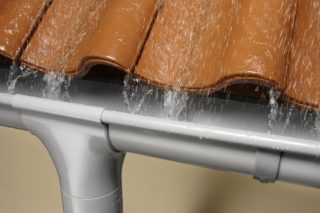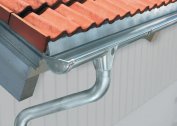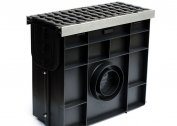The drainage system is an essential element of the sewage system. For its arrangement, it is necessary to select the material from which the gutters will be made, then lay underground pipelines to divert water from the site. If you do not take care of this, annually tons of melt and rainwater will soak the soil under the foundation, as a result of which it can sag, the walls at the same time crack or collapse - in the best case decorative plaster will fall. A high-quality drainage system is especially important for a newly built house, where the soil has not yet sagged enough and there is a risk of structural destruction.
Why do we need a drainage system

Puddles on the sidewalk, faded paint on the walls and dirty stains - all this is the result of savings on the construction of the drainage system. If the site is in a lowland, then water from neighboring territories will accumulate under the house. If the soil gains a lot of fluid, decorative crops cannot grow on it, since without sufficient air in the soil they will die. The same goes for the garden. In addition to gutters and drainpipes, it is necessary to provide a system of channels through which liquid will flow into a septic tank or into a common ditch.
In addition to practical value, stormwater has an aesthetic function. In accordance with the style in which the house is built, a system of suspension devices is selected for collecting liquid, transporting it to the gutters. Stormwater can be bought ready-made or assembled on its own. For this, there are several varieties of materials that are most often used for the installation of gutters.
Classification of gutter systems for installation and materials
Gutter systems are distinguished by installation method, shape and materials. There are two types of drains. One of them is designed for a sloping roof and is called open - all elements are located outside the house. Another view, closed, is designed for a flat roof. Each has its advantages and disadvantages.
The disadvantage of an open system is its vulnerability to mechanical damage, ultraviolet, frost. For the arrangement, you need to choose durable materials. In winter, additional heating of the structure may be necessary so that water does not freeze in the gutters and icicles do not form. To avoid fluid stagnation, builders observe a slight bias so that it moves faster towards the pipe and flows down.
In internal systems, funnels are used for drainage, which in the required amount are evenly distributed over the entire surface of the roof. The outlet elements are connected into one common pipe through which liquid flows into the storage.
There are rectangular and round systems. Round ones are more practical, as the speed of water in them is higher. It’s easier to build a round gutter with your own hands, since ready-made plastic pipes are used for this. For gutters, they are simply cut in half and strip the edges.
Of the materials that are most often used in the production of drainage systems, we can distinguish:
- galvanized steel;
- aluminum;
- plastic;
- copper.
Galvanized steel and aluminum are cheap options for organizing a drain. They are light weight, easy to install, do not overload the mounts under the roof. Steel undergoes corrosion after some time, but when it comes to cost, this is the best option.
High-strength plastic can be selected by color. It is UV protected and light in weight.Ready-made designs can be ordered from the manufacturer, and assembled independently. It does not take much time. A set of gutter system made of plastic will cost more than a home-made design, but this option looks much more aesthetic. Plastic will serve more than 50 years in the absence of external damage.
The prices for copper drainage systems are the highest, since the material is durable. According to theoretical data, copper has not lost its qualities for about 300 years. Copper products with the addition of other metals are able to tolerate heat and frost, withstand shocks of large hail. At the same time, the material is lightweight and does not create stress on the walls and roof elements.
Elements of the drainage system
The main structural element is the gutter. He takes water from the roof and directs it into the pipe. It is mounted on brackets that repeat the shape of the gutter - round or rectangular. If the building has corners, there are corner elements - there are internal and external shapes. On the gutters, plugs are installed at the edges so that the liquid does not spill out. In places of risers funnels join them, through which water flows into a pipe.
Thanks to straight and corrugated pipes, it is possible to build gutters of any configuration - in the shape of the roof. For convenience, manufacturers produce tees for connecting several gutters located at different heights to one riser. The riser ends with a knee so that it is convenient to divert fluid at an angle.
The riser is attached using clamps that are screwed to the wall. This additionally fixes the structure, protecting it from wind and shock.
On the ground, trays for collecting liquid are mounted, through which it is transported to sedimentation tanks or discharged outside the site. Trays on top are covered with removable grilles. If necessary, they can be opened and cleaned of debris.
Gutter Design Requirements
The materials used in the manufacture must comply with the requirements of GOST for gutter systems. Given the characteristics of the region, it is necessary to select metal or plastic that can withstand maximum and minimum temperatures.
Much attention is paid to small details, such as brackets, which bear the entire load. Brackets are often made of durable metal, which is likely to hold the structure in strong winds.
The coefficient of thermal expansion is an indicator that is taken into account when selecting materials. When heated, they expand, at low temperatures they contract. In regions with a difficult climate, it is necessary to take into account the resistance of drains to a sharp change in temperature, since the declared service life can vary significantly - due to differences in products, they deteriorate faster.
Before installation, mass calculations of the entire structure and the ratios of the mounting materials are performed. You can do it yourself according to the instructions or entrust the layout to professionals.
Necessary calculations
First of all, the amount of consumables is calculated - pipes, gutters, brackets, funnels, plugs, corner elements - internal and external. For this, the perimeter of the building and the height are measured. You need to buy materials with a margin of 20% in case of lack of gutters or length of risers.
When calculating the number of brackets, it should be borne in mind that for plastic systems they are screwed every 60 cm, for metal systems every 110 cm.
The number of drainage funnels corresponds to the number of risers. When calculating the mounting clamps for vertical pipes are oriented to the height of the building. For one-story houses, two clamps for one riser are enough.
The number of screws for fasteners is bought with a margin.
Walkthrough for installation of gutters
 Collect the drainage system begin from above. First of all, the brackets are screwed. It is important to observe the bias. If the wall length is about 10 m, you can do it in one direction.If more, the slope is performed from the center of the wall in different directions. To correctly make a bias, fasten the first and last brackets at different levels, pull the fishing line between them, the rest screw them, focusing on the level of the fishing line, observing the required step.
Collect the drainage system begin from above. First of all, the brackets are screwed. It is important to observe the bias. If the wall length is about 10 m, you can do it in one direction.If more, the slope is performed from the center of the wall in different directions. To correctly make a bias, fasten the first and last brackets at different levels, pull the fishing line between them, the rest screw them, focusing on the level of the fishing line, observing the required step.
After mounting the fasteners, they begin to assemble the gutters. This is done for convenience on the ground, and then lifted and stacked in brackets. When the horizontal structure is ready, proceed with the installation of vertical risers. It is important here to correctly fix the clamps and pipes so that they move freely inside the holders. This is necessary so that the clamp does not damage the riser due to thermal deformation of the pipes.
Prices for finished gutters vary depending on the amount of consumables and its quality. Plastic is cheaper than copper. The cost of the gutter system of rectangular cross section practically does not differ from similar round ones, although in many respects it is more practical.



